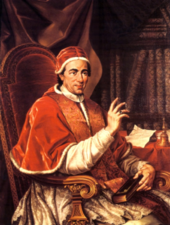Conclave 1769
The conclave of 1769 occurred after the death of Pope Clement XIII. († February 2, 1769 ) and met from February 15, 1769 to May 15, 1769. It lasted 93 days and elected Clement XIV. As Pope.
College of Cardinals
When Pope Clement XIII. died, which was one of the College of Cardinals 57 cardinals .
Attendees
The 46 cardinals attending the conclave were:
- Carlo Alberto Guidobono Cavalchini , Cardinal Bishop of Ostia and Velletri , Dean of the College of Cardinals
- Federico Marcello Lante , Bishop of Porto e Santa Rufina , Subdean of the College of Cardinals
- Giovanni Francesco Albani , Bishop of Sabina
- Henry Benedict Mary Clement Stuart of York , Bishop of Frascati , Vice Chancellor of the Holy Roman Church
- Fabrizio Serbelloni , Bishop of Albano
- Giovanni Francesco Stoppani , Bishop of Palestrina
- Giuseppe Pozzobonelli , Archbishop of Milan
- Carlo Vittorio Amedeo delle Lanze
- Vincenzo Malvezzi , Archbishop of Bologna
- Antonino Sersale , Archbishop of Naples
- Francisco de Solís Folch de Cardona , Archbishop of Seville
- Paul d'Albert de Luynes , Archbishop of Sens
- Carlo Rezzonico the Younger , Camerlengo of the Holy Roman Church
- Antonio Marino Priuli , Bishop of Vicenza
- François-Joachim de Pierre de Bernis , Archbishop of Albi
- Ferdinando Maria de Rossi , Prefect of the Congregation for the Tridentine Council
- Girolamo Spinola , Papal Legate in Ferrara
- Giuseppe Maria Castelli , Prefect of the Congregation Propaganda Fide
- Gaetano Fantuzzi
- Pietro Girolamo Guglielmi
- Pietro Paolo Conti
- Lorenzo Ganganelli , OFMConv (elected Pope as Clement XIV)
- Marcantonio Colonna the Younger , Vicar General for the City of Rome and its districts
- Buenaventura de Córdoba Espínola de la Cerda , Patriarch of the West Indies
- Giovanni Molino , Bishop of Brescia
- Simone Buonaccorsi
- Giovanni Ottavio Bufalini , Archbishop, Bishop in Ancona
- Giovanni Carlo Boschi
- Ludovico Calini
- Antonio Branciforte Colonna , President of Urbino
- Lazzaro Opizio Pallavicini , Papal Legate in Bologna
- Vitaliano Borromeo , Papal Legate in Romandiola
- Pietro Colonna Pamphili
- Urbano Paracciani , Archbishop of Fermo
- Filippo Maria Pirelli
- Alessandro Albani , OSIo.Hieros. , Librarian of the Holy Roman Church
- Neri Maria Corsini , Archpriest of the Lateran Basilica and Secretary of the Holy Office
- Domenico Orsini d'Aragona
- Flavio Chigi the Younger , Prefect of the Congregation for Rites
- Luigi Maria Torregiani , Cardinal Secretary of State
- Giovanni Costanzo Caracciolo
- Niccolò Perelli
- Andrea Corsini
- Andrea Negroni
- Saverio Canali
- Benedetto Veterani
Cardinals not participating in the conclave
The following cardinals could not take part in the conclave:
- Giacomo Oddi , Archbishop ad personam , Bishop of Viterbo and Toscanella
- Carlo Francesco Durini , Titular Archbishop of Amasea , Bishop of Pavia
- Luis Antonio Fernández de Córdoba , Archbishop of Toledo
- Étienne-René Potier de Gesvres , Bishop of Beauvais
- Franz Konrad Kasimir Ignaz von Rodt , Bishop of Constance
- Francisco de Saldanha da Gama , Patriarch of Lisbon
- Christoph Anton von Migazzi , Archbishop of Vienna
- Antoine Clériadus de Choiseul de Beaupré , Archbishop of Besançon
- Jean-François-Joseph Rochechouart de Faudoas , Bishop of Laon
- Franz Christoph von Hutten zum Stolzenberg , Bishop of Speyer
- Louis César Constantin de Rohan-Guéméné , Bishop of Strasbourg
conclave
Before the beginning of the conclave, the Italian cardinals gathered in a first congregation wanted to elect Flavio Chigi as pope by acclamation , but this was prevented by the intervention of the French ambassador.
When the conclave met on February 15, 1769, there were 46 participants. Eleven cardinals stayed away from the election. The venue of the conclave was the Vatican.
The three-month conclave was overshadowed by the Jesuit question and the pressure exerted on the college of cardinals by the Bourbon states of Portugal, Spain and France. Two parties faced each other: cardinals, who were close to the Bourbon crowns and were opponents of the Jesuits, and the group of Zelanti , friends of the order.
Against the election of Simone Buonaccorsi , the French King Louis XV. his veto.
On March 20, 1769, Emperor Joseph II was allowed to visit the conclave and take a look at the cardinals' cells, whose beautiful furnishings he admired.
After the 185th ballot, the cardinals agreed on Ganganelli, who was elected Pope on May 19, 1769 and who took the name Clemens in memory of his predecessor.
literature
- Secret and reliable story of the conclave and the election of the six last Popes, as: Benedict XIII. Clement XII. Benedict XIV. Clement XIII. Clement XIV. And Pius the VIth. Sonnleithner, 1782, p. 28f.
Web links
- Conclave of February 15 - May 19, 1769. In: Salvador Miranda : The Cardinals of the Holy Roman Church. ( Florida International University website), accessed June 17, 2015.
- Entry for Conclave 1769 on catholic-hierarchy.org , viewed January 21, 2017
- Pope Clement XIV. In: Vaticanhistory. Retrieved June 25, 2015 .


